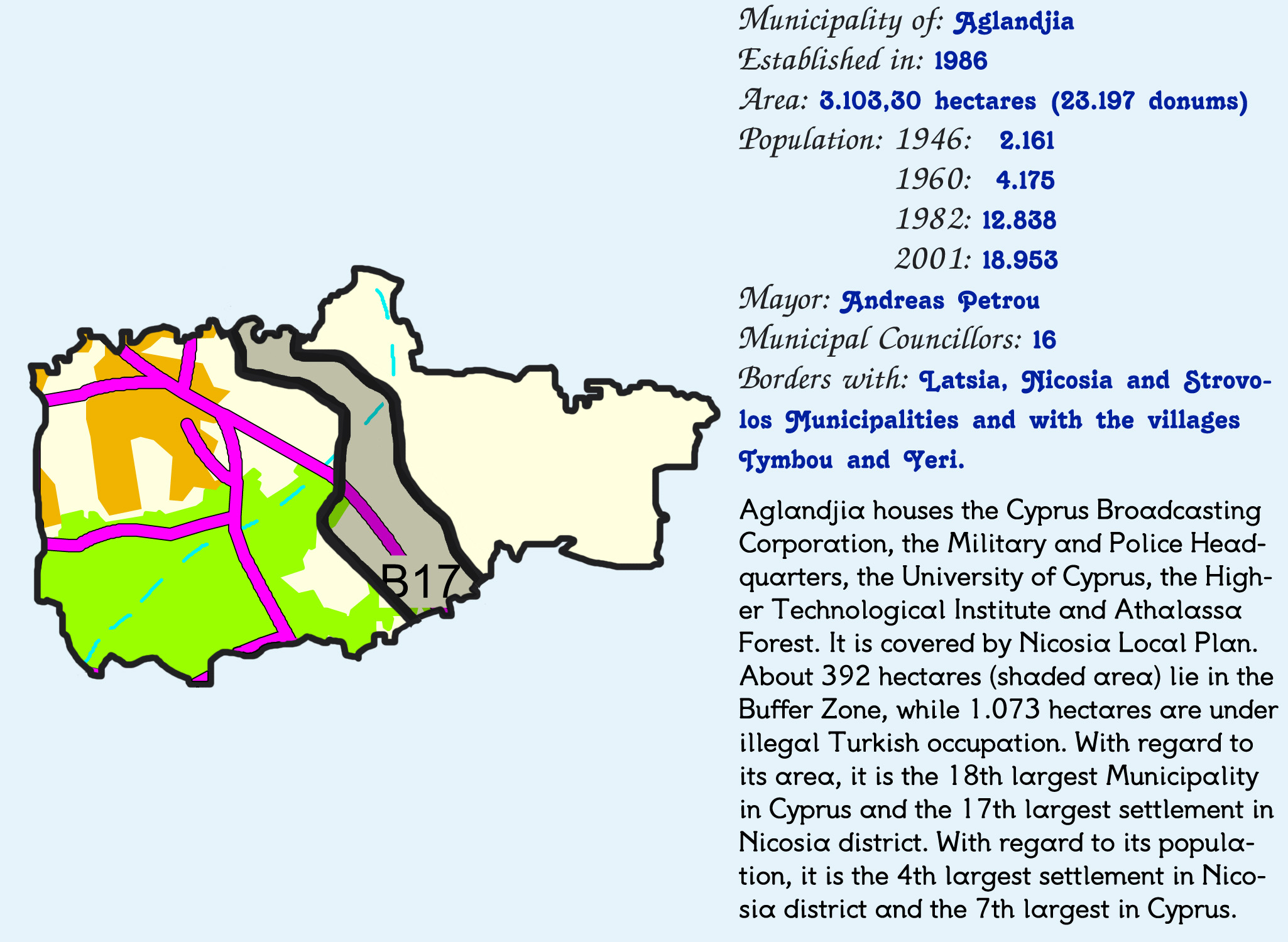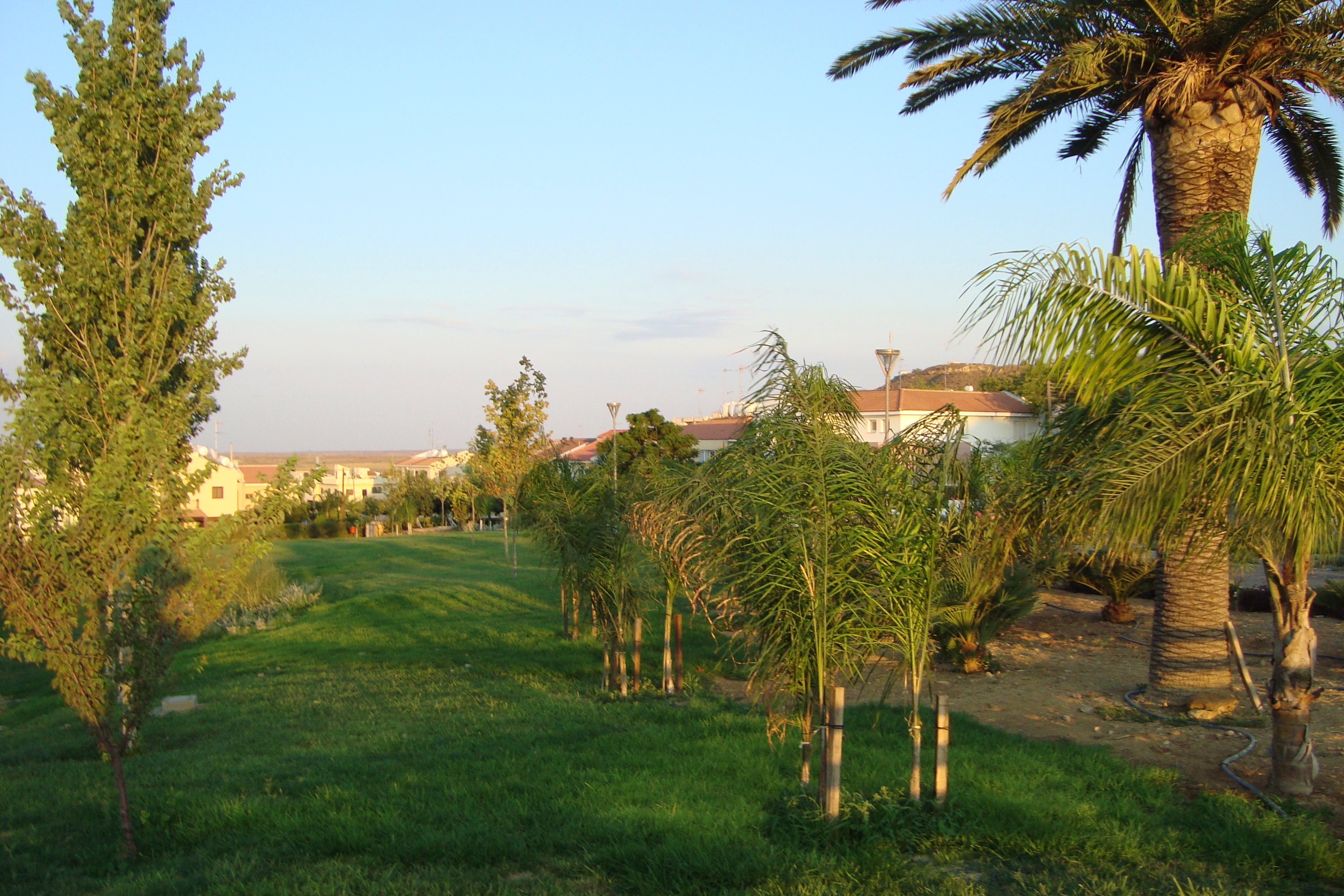Aglandjia on:
[Wikipedia]
[Google]
[Amazon]
 Aglandjia ( []; ) is a suburb and municipality of
Aglandjia ( []; ) is a suburb and municipality of
 Aglandjia was declared a Municipality by a referendum in May 1986. The Municipal Council is made up of the mayor and sixteen Municipal Councilors. The current mayor is Andreas Konstantinou. Aglandjia Municipality employs 24 permanent employees and 30 workers (permanent and casual) who staff the services below, which have their seat in the Town Hall:
* Secretariat
* Technical services
* Financial services
* Greenery and Environment services
* Hygiene services
* Cultural services
Aglandjia was declared a Municipality by a referendum in May 1986. The Municipal Council is made up of the mayor and sixteen Municipal Councilors. The current mayor is Andreas Konstantinou. Aglandjia Municipality employs 24 permanent employees and 30 workers (permanent and casual) who staff the services below, which have their seat in the Town Hall:
* Secretariat
* Technical services
* Financial services
* Greenery and Environment services
* Hygiene services
* Cultural services
 The history of Aglandjia goes back as far as 3888 BC. Several tombs dating to the
The history of Aglandjia goes back as far as 3888 BC. Several tombs dating to the
Aglandjia Municipality
*
Old website
Gazetteer Entry
https://archive.primarias1.ro/orase-infratite/acord_infratire_aglanzia.pdf {{Municipalities of Cyprus Municipalities in Nicosia District Suburbs of Nicosia
 Aglandjia ( []; ) is a suburb and municipality of
Aglandjia ( []; ) is a suburb and municipality of Nicosia
Nicosia, also known as Lefkosia and Lefkoşa, is the capital and largest city of Cyprus. It is the southeasternmost of all EU member states' capital cities.
Nicosia has been continuously inhabited for over 5,500 years and has been the capi ...
, Cyprus. The municipality has a population of 20,783 (2011) and is contiguous with the Nicosia Municipality.
Aglandjia is near the United Nations Buffer Zone in Cyprus, buffer zone. It has an area of about 31 km2, of which 14 km2 is agricultural land that has been Turkish invasion of Cyprus, occupied by the Turkish army since 1974; of the remaining 17 km2, 9 km2 are national forest parks (Athalassa park, 8.6 km2 and Pedagogical Academy park 0.4 km2).
Name
The word ''Aglandjia'' is of Turkish origin, deriving from , meaning "entertainment". Its pronunciation inCypriot Greek
Cypriot Greek (, or ) is the variety of Modern Greek that is spoken by the majority of the Cypriot populace and Greek Cypriot diaspora. It is considered a divergent dialect as it differs from Standard Modern Greek in various aspects of its ...
is .
Another theory states that the name derives from the surname of the Frankish family de Aglande, who owned the area during the Frankish rule in Middle Ages.
Administration
 Aglandjia was declared a Municipality by a referendum in May 1986. The Municipal Council is made up of the mayor and sixteen Municipal Councilors. The current mayor is Andreas Konstantinou. Aglandjia Municipality employs 24 permanent employees and 30 workers (permanent and casual) who staff the services below, which have their seat in the Town Hall:
* Secretariat
* Technical services
* Financial services
* Greenery and Environment services
* Hygiene services
* Cultural services
Aglandjia was declared a Municipality by a referendum in May 1986. The Municipal Council is made up of the mayor and sixteen Municipal Councilors. The current mayor is Andreas Konstantinou. Aglandjia Municipality employs 24 permanent employees and 30 workers (permanent and casual) who staff the services below, which have their seat in the Town Hall:
* Secretariat
* Technical services
* Financial services
* Greenery and Environment services
* Hygiene services
* Cultural services
History
 The history of Aglandjia goes back as far as 3888 BC. Several tombs dating to the
The history of Aglandjia goes back as far as 3888 BC. Several tombs dating to the Bronze Age
The Bronze Age () was a historical period characterised principally by the use of bronze tools and the development of complex urban societies, as well as the adoption of writing in some areas. The Bronze Age is the middle principal period of ...
have been found on Arona Hill (Mount Lion or Liontarovounos). The hill is strategically located for the defense of the area, so the settlement there was most likely a military deployment during the first phase of its history.
Around the hill there was an ancient settlement, from which the city of Ledra may have originated. Archaeological works of art and inscriptions in the Cypriot syllabary
The Cypriot or Cypriote syllabary (also Classical Cypriot Syllabary) is a syllabary, syllabic script used in Iron Age Cyprus, from about the 11th to the 4th centuries BCE, when it was replaced by the Greek alphabet. It has been suggested that t ...
have been found in Kafizin or Small Aronas, a historic site with a cave dedicated to the worship of a Nymph
A nymph (; ; sometimes spelled nymphe) is a minor female nature deity in ancient Greek folklore. Distinct from other Greek goddesses, nymphs are generally regarded as personifications of nature; they are typically tied to a specific place, land ...
. These objects indicate the site was in use as a place of worship
Worship is an act of religious devotion usually directed towards a deity or God. For many, worship is not about an emotion, it is more about a recognition of a God. An act of worship may be performed individually, in an informal or formal group, ...
during the Hellenistic period
In classical antiquity, the Hellenistic period covers the time in Greek history after Classical Greece, between the death of Alexander the Great in 323 BC and the death of Cleopatra VII in 30 BC, which was followed by the ascendancy of the R ...
, specifically between 225 and 218 BC, during the reigns of Ptolemy the Benefactor and Ptolemy Philopatoras.
A variety of locally manufactured pottery was also found at the site, including various bowls, two-handled vessels, cup-bearers, feeding bottles, mud-lighters, jars, cooking utensils, frying pans, wash basins, jugs, combined pots, urns, amphorae, rhytons, large jars and jar lids, and objects testifying to the practice of weaving.
In the Middle Ages
In the history of Europe, the Middle Ages or medieval period lasted approximately from the 5th to the late 15th centuries, similarly to the post-classical period of global history. It began with the fall of the Western Roman Empire and ...
, the Lefkomiatis settlement was in the area of Aglandjia. The area seems to have been inhabited towards the end of Frankish
Frankish may refer to:
* Franks, a Germanic tribe and their culture
** Frankish language or its modern descendants, Franconian languages, a group of Low Germanic languages also commonly referred to as "Frankish" varieties
* Francia, a post-Roman ...
rule, during the reign of Jacques II (1468–1473). The medieval La Cava castle, built on Arona hill around 1385 by King Jacques I, was used as an observatory for the control of the road leading from Larnaca
Larnaca, also spelled Larnaka, is a city on the southeast coast of Cyprus and the capital of the Larnaca District, district of the same name. With a district population of 155.000 in 2021, it is the third largest city in the country after Nicosi ...
to Nicosia
Nicosia, also known as Lefkosia and Lefkoşa, is the capital and largest city of Cyprus. It is the southeasternmost of all EU member states' capital cities.
Nicosia has been continuously inhabited for over 5,500 years and has been the capi ...
.The castle took its name from the large rock cistern which still survives today.
The castle was blasted by the Venetians during the third decade of the 16th century, while the Ottomans
Ottoman may refer to:
* Osman I, historically known in English as "Ottoman I", founder of the Ottoman Empire
* Osman II, historically known in English as "Ottoman II"
* Ottoman Empire
The Ottoman Empire (), also called the Turkish Empir ...
used the bigger of its two towers as a powder magazine. Up until 1870 a considerable amount of the castle was still standing, including the vaulted hall, the curtain walls, and two towers. However, the majority of the castle was pulled down in that year to build the Church of Phaneromeni. In 1888 the area was excavated by M. R. James
Montague Rhodes James (1 August 1862 – 12 June 1936) was an English medievalist scholar and author who served as provost of King's College, Cambridge (1905–1918), and of Eton College (1918–1936) as well as Vice-Chancellor of the Univers ...
. The castle was proclaimed an ancient moment in 1915. Today a portion of the Great Tower and Second Tower exists together with the cistern.Touring Guide of Nicosia 1994
After the conquest of Cyprus by the Ottomans, the Aglandjia settlement declined. It started to form a self-sufficient rural settlement around the end of the 18th century whose inhabitants engaged in farming, stockbreeding, and quarrying. Around the end of the 18th century, Dragoman Hadjigeorgakis Kornesios erected Ayios Yeoryios church on the site of the cemetery and Ayios Yeoryios church in Athalassa.
Aglandjia contributed organized groups to the EOKA
The Ethniki Organosis Kyprion Agoniston (EOKA ; ) was a Greek Cypriot nationalist guerrilla organization that fought a campaign for the end of Cyprus#Cyprus under the British Empire, British rule in Cyprus, and for enosis, eventual union with K ...
struggle, and local volunteers also participated in the events of 1964. Aglandjia was bombed during the Turkish invasion of 1974. The Turkish army
The Turkish Land Forces () is the main branch of the Turkish Armed Forces responsible for Army, land-based military operations. The army was formed on November 8, 1920, after the collapse of the Ottoman Empire. Significant campaigns since the ...
continues to occupy 45% of the municipality's territory.
International relations
Twin towns – Sister cities
Aglandjia is twinned with: *Zografou
Zografou () is a suburban town of approximately 70,000 inhabitants in the eastern part of the Athens agglomeration, Greece. It was named after the Greek politician Ioannis Zografos. To the east of Zografou lies mount Hymettus. The area, being ...
, Greece (since 1988)
* Kalamata
Kalamata ( ) is the second most populous city of the Peloponnese peninsula in southern Greece after Patras, and the largest city of the Peloponnese (region), homonymous administrative region. As the capital and chief port of the Messenia regiona ...
, Greece (since 1993)
* Azov
Azov (, ), previously known as Azak ( Turki/ Kypchak: ),
is a town in Rostov Oblast, Russia, situated on the Don River just from the Sea of Azov, which derives its name from the town. The population is
History
Early settlements in the vici ...
, Russia (since 1998)Friendly cities
Aglandjia also cooperates with: * Fontaine l'Eveque, Belgium *Bucharest
Bucharest ( , ; ) is the capital and largest city of Romania. The metropolis stands on the River Dâmbovița (river), Dâmbovița in south-eastern Romania. Its population is officially estimated at 1.76 million residents within a greater Buc ...
, Romania
* Kyiv
Kyiv, also Kiev, is the capital and most populous List of cities in Ukraine, city of Ukraine. Located in the north-central part of the country, it straddles both sides of the Dnieper, Dnieper River. As of 1 January 2022, its population was 2, ...
, Ukraine
* Rome
Rome (Italian language, Italian and , ) is the capital city and most populated (municipality) of Italy. It is also the administrative centre of the Lazio Regions of Italy, region and of the Metropolitan City of Rome. A special named with 2, ...
, Italy
References
External links
Aglandjia Municipality
*
Old website
Gazetteer Entry
https://archive.primarias1.ro/orase-infratite/acord_infratire_aglanzia.pdf {{Municipalities of Cyprus Municipalities in Nicosia District Suburbs of Nicosia